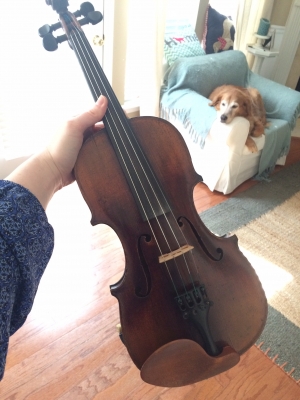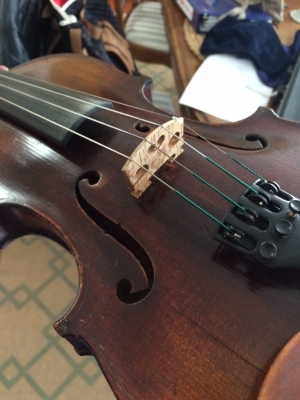Welcome to our forum. A Message To Our New and Prospective Members . Check out our Forum Rules. Lets keep this forum an enjoyable place to visit.
Currently working on errors from the latest (SimplePress) forum update. Many issues have been resoled and others are being worked on. Thank you for your patience.
 Topic RSS
Topic RSS Related Topics
Related Topics




 (0 votes)
(0 votes) Member
 Offline
OfflineGood afternoon, fiddlers!!
I am a novice fiddler and looking to buy a new instrument to replace my student palatino that sound pretty awful. For my 30th birthday, my husband said I could get new violin! yay. My price range has proven difficult (trying to keep it less than 1K) as far as the number of violins I have to choose from.
I've been working with fiddlershop and am going to try another one of theirs out. I sent back the Master bc that particular violin was a little bright for my taste. However, I was referred to this little shop by my instructor as a good place to start so I went there too. The guy makes his own violins and also sells. He's been doing this since he was a teenager and seems to have a pretty reputable business. There were two that I really liked and I have them both at my house right now to try them on for size.
One is an antique. Described to me as “probably from the 1800’s” and “made in Germany”. However, when peering through the F holes, it says:
“Geo Lejko expert violin maker Cleveland, OH" (stamped)
In pencil it says “repair 1920 (something I can’t read) rd”
So I’m left wondering- is this guy pulling my leg?? He said he was selling it for a customer. So in his defense he may not have checked it out thoroughly.... He priced it at $1200 but thought it was probably worth more. It sounds like a dream. Very warm tones.
Thoughts? I’ll try to attach pictures…
Thanks for any insight any of you may have!!
Sarah
Member
 Offline
OfflineLovely colour 🙂
but some thoughts:
This hairline under the Bass f-hole, its a surface crack or a crack? Is it the 1920 repair written inside the violin?
Personally I would buy a violin with a repaired crack only and only if
1) I really trust the person that did the repair, or has recently removed the top and inspected it thoroughly
2) I REALLY REALLY love the sound of it and its way better than other instrument in its price range
3) It's a bargain indeed. Cracks and previous repairs on the violin itself (apart from the fingerboard) do reduce the price of the instrument and often dramatically. This however does not mean by itself that the instrument is not great. If the repair is done properly, you may never encounter any issues.
But I would make sure that all three points are covered.
Hope i did not confuse you 🙂
Member
 Offline
OfflineHermes-
Thanks for your reply!! So I do not personally know the shop owner well, but he came highly recommended by my instructor who has been a violinist and instructor in the area for quite some time now. Talking to the shop owner, he seemed really knowledgable.
As far as the discrepancy from what he told me in the shop (re: the age and origin of the violin: 1800's and Germany) I emailed him. His reply was that many times old violins have these old repair stamps in them and that it is much older than 1920. I felt satisfied by that (I think...or to naive to know any different).
The 1920: It was hand written in the violin in pencil that said "repair 1920" with a stamp that read "Geo Lejko expert violin maker Cleveland O"
The sound is amazing. Its warm and beautiful and I love it under my ear.
The crack(s): he has NOT taken the top off and inspected them himself but he thought that the repairs looked good as best he could tell (he was saying that he wouldn't truly know unless he took the top off and looked himself, but since it is not his violin [he's selling it for another customer] he had not done that.
Thoughts?? I appreciate any and all that you more knowledgeable violinist have!! 🙂
-Sarah
Sarah,
I think that the clue is that the luthier himself told that he wouldn't truly know unless he took the top off. Which is honest, and right, and professional I guess. And the fact is that the top will remain in place for the time being.
So there appears to be no guarantee that the crack should be trouble-free.
This price range of this instrument (1200 USD) should lead you to many old violins of the 19th century, not only Americans, but Germans, Bohemians etc. These instruments could be great as you may have discovered with this one, but in order not to spend further to their reconditioning, or repair, you can get one that a luthier has recently checked and he truly knows.
I am not trying to discourage you but in the worst case scenario that such a crack becomes "active" again, you would need to remove the top and repair. And I don't think that something like this would cost less than 300 dollars, since removing the top and gluing it back ( without the real repair), is a lot of work by itself. And you really need to think of that, and of course all the discomfort this could bring you.
If I was about to make this choice, I would at least try a few other violins beforehand. Around the 1K price tag, you may find a very decent instrument, either old like the one you are trying or a contemporary Chineese from a descent workshop, set up by a luthier in the US for example.
On the "financial" side of things, since you are investing a certain amount of money, and you try to keep it on a budget, get a violin that somebody can somehow guarantee that you are not going to spend more any time soon.
I would be optimistic its indeed possible to find many great instruments in this price range nowadays.
Honorary tenured advisor
Regulars
 Offline
OfflineMember
 Offline
Offline Offline
Offline

I am agreeing with Hermes, as this is a consignment item for the luthier I wouldn't feel he had professional investment in this instrument, and I see 3 cracks, not 1... I know you are feeling it sounds great but at a minimum I would look further in that price range I think you can do much better than this leap of faith instrument, just my opinion! This one while very pretty does not look stable to me...
1 Guest(s)


 Log In
Log In Register
Register




























